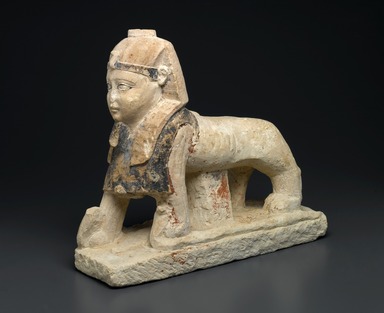
Medium: Limestone, pigment
Geograhical Locations:
Dates:1st century C.E. or later
Dimensions: 14 1/4 x 5 1/16 x 16 11/16 in. (36.2 x 12.8 x 42.4 cm) mount (display dimensions): 14 1/2 x 5 1/2 x 17 in. (36.8 x 14 x 43.2 cm)
Collections:
Museum Location: 19th Dynasty to Roman Period, Martha A. and Robert S. Rubin Gallery, 3rd Floor
Exhibitions:
Accession Number: 37.1509E
Image: 37.1509E_threequarterleft_PS1.jpg,
Catalogue Description: One limestone statue of the god Tutu. It strides forward with right front leg advanced. Both forepaws rest upon snakes which curl up to rear back upon the calves of the forelegs. The figure bears a short tail. The god is human headed and is shown wearing an Aegis. The bottom edge of which sports a much abbreviated gorgon head. The head of the main figure is enclosed in a Nemes headdress with very narrow lappets, the pleats being painted on. On the brow a single cobra is placed. The face is broadly modelled; the eyes are extremely shallow and heavily outlined by non-naturalistic cosmetic lines. The nose, though lost, was fairly narrow, and shallow naso-labial furrows are noted. The orbital ridges are shown as straight hard lines. The mouth is small and deeply set with a sharp philtrum. The chin is weak and an unconvincing beard extends as a rectangle beneath it. The ears are placed too high on the head and are too small. Atop the nemes a circular projection with a hole served to receive some kind of support rod. Beneath the figure a stabilizing block of limestone has been left to support the figure on its plinth. Condition: The nose is wanting and the right cheek and nemes lappet are slightly chipped. Chisel marks are evident down the back of the nemes and along the axis of the body. The plinth is roughly finished. The aegis bears almost all of its black paint, while the body, support and plinth are devoid to a great extent of the red paint which once covered them. The pleats of the lappets are partially evident as is the black paint on the brow band. Overall chipping.